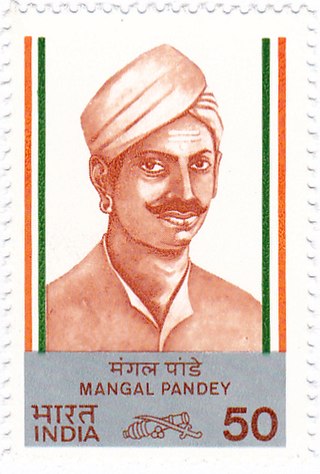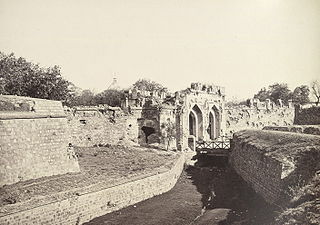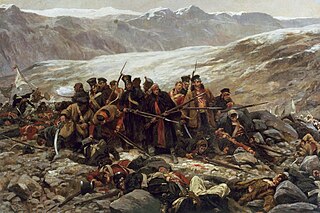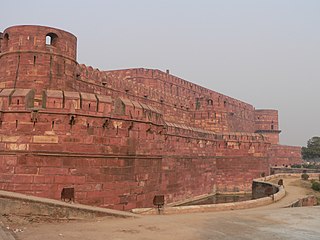
The Braddock expedition, also called Braddock's campaign or Braddock's Defeat, was a British military expedition which attempted to capture Fort Duquesne from the French in the summer of 1755, during the French and Indian War of 1754 to 1763. The British troops suffered defeat at the Battle of the Monongahela on July 9, 1755, and the survivors retreated. The expedition takes its name from General Edward Braddock (1695–1755), who led the British forces and died in the effort. Braddock's defeat was a major setback for the British in the early stages of the war with France; John Mack Faragher characterises it as one of the most disastrous defeats for the British in the 18th century.

The Battle of Plassey was a decisive victory of the British East India Company, under the leadership of Robert Clive, over the Nawab of Bengal and his French allies on 23 June 1757. The victory was made possible by the defection of Mir Jafar, Nawab Siraj-ud-Daulah's commander in chief. The battle helped the British East India Company take control of Bengal in 1772. Over the next hundred years, they continued to expand their control over vast territories in rest of the Indian subcontinent, including Burma.

The Indian Rebellion of 1857 was a major uprising in India in 1857–58 against the rule of the British East India Company, which functioned as a sovereign power on behalf of the British Crown. The rebellion began on 10 May 1857 in the form of a mutiny of sepoys of the company's army in the garrison town of Meerut, 40 mi (64 km) northeast of Delhi. It then erupted into other mutinies and civilian rebellions chiefly in the upper Gangetic plain and central India, though incidents of revolt also occurred farther north and east. The rebellion posed a military threat to British power in that region, and was contained only with the rebels' defeat in Gwalior on 20 June 1858. On 1 November 1858, the British granted amnesty to all rebels not involved in murder, though they did not declare the hostilities to have formally ended until 8 July 1859.

Duncan William Ferguson Lamont was a British actor. Born in Lisbon, Portugal, and brought up in Scotland, he had a long and successful career in film and television, appearing in a variety of high-profile productions.

Mangal Pandey was an Indian soldier who played a key role in the events taking place just before the outbreak of the Indian rebellion of 1857. He was a sepoy (infantryman) in the 34th Bengal Native Infantry (BNI) regiment of the British East India Company. In 1984, the Indian government issued a postage stamp to remember him. His life and actions have also been portrayed in several cinematic productions.

Brigadier General John Nicholson, was an Anglo-Irish officer in the British Army who rose to prominence during his career in British India. Born in Ireland, Nicholson moved to the Indian subcontinent at a young age and obtained a commission in the East India Company where he spent the majority of his life helping to expand Company rule in numerous conflicts such as the First Anglo-Afghan War and the First and Second Anglo-Sikh War. Nicholson created a legend for himself as a political officer under Henry Lawrence in the frontier provinces of British India, especially in the Punjab, and he was instrumental in the establishment of the North-West Frontier. Nicholson's most defining moment in his military career was his crucial role in suppressing the Indian Rebellion of 1857, a conflict in which he died.

The Battle of Maiwand, fought on 27 July 1880, was one of the principal battles of the Second Anglo-Afghan War. Under the leadership of Ayub Khan, the Afghan forces defeated a much smaller British force consisting of two brigades of British and Indian troops under Brigadier-General George Burrows, albeit at a high price: between 2,050 and 2,750 Afghan warriors were killed, and probably about 1,500 wounded. British and Indian forces suffered 1,200 dead.

General Bakht Khan (1797–1859) was the commander-in-chief of the Indian rebel forces in the city of Delhi during the Indian Rebellion of 1857 against the East India Company.

The Kabul Expedition was a punitive campaign undertaken by the British against the Afghans following the disastrous retreat from Kabul. Two British and East India Company armies forced through the Khyber Pass and advanced on the Afghan capital from Kandahar and Jalalabad to avenge the complete annihilation of the British-Indian military-civilian column in January 1842.

Zarak is a 1957 CinemaScope adventure film based on the 1949 book The Story of Zarak Khan by A.J. Bevan. It was directed by Terence Young with assistance from John Gilling and Yakima Canutt. Set in the Northwest Frontier, the film stars Victor Mature, Michael Wilding and Anita Ekberg and features Patrick McGoohan in a supporting role.

The Siege of Delhi was one of the decisive conflicts of the Indian Rebellion of 1857. The rebellion against the authority of the East India Company was widespread through much of Northern India, but essentially it was sparked by the mass uprising by the sepoys of the Bengal Army, which the company had itself raised in its Bengal Presidency. Seeking a symbol around which to rally, the first sepoys to rebel sought to reinstate the power of the Mughal Empire, which had ruled much of the Indian subcontinent in the previous centuries. Lacking overall direction, many who subsequently rebelled also flocked to Delhi.

Ronald Glasfryn Lewis was a Welsh actor, best known for his appearances in British films of the 1950s and 1960s.

Operation Mountain Fury was a NATO-led operation begun on September 16, 2006 as a follow-up operation to Operation Medusa, to clear Taliban insurgents from the eastern provinces of Afghanistan. Another focus of the operation was to enable reconstruction projects such as schools, health-care facilities, and courthouses to take place in the targeted provinces.

The 1842 retreat from Kabul was the retreat of the British and East India Company forces from Kabul during the First Anglo-Afghan War. An uprising in Kabul forced the then-commander, Major-General William Elphinstone, to fall back to the British garrison at Jalalabad. As the army and its numerous dependents and camp followers began their march, it came under attack from Afghan tribesmen. Many in the column died of exposure, frostbite or starvation, or were killed during the fighting.

The 1915 Singapore Mutiny, was a mutiny of elements of the British Indian Army's 5th Light Infantry in the colony of Singapore. Up to half of the regiment, which consisted of Indian Muslims, mutinied on 15 February 1915 due to rumours that they would be sent to fight against the largely Muslim Ottoman Empire as part of the Middle Eastern theatre of World War I. The mutineers killed 36 soldiers and civilians before the mutiny was suppressed by Allied forces. After the mutiny, more than 205 mutineers were tried by court-martial, and 47 were sentenced to execution by firing squad.
The Battle of Badli-ki-Serai was fought early in the Indian Rebellion of 1857, or First War of Indian Independence as it has since been termed in Indian histories of the events. A British and Gurkha force defeated a force of sepoys who had rebelled against the British East India Company. The British victory allowed them to besiege and ultimately capture Delhi.

The Battle of Agra was a comparatively minor but nevertheless decisive action at the end of a prolonged siege during the Indian Rebellion of 1857.

The Battle of Najafgarh was a subsidiary engagement of the Siege of Delhi during the Indian Rebellion of 1857. A large Indian force sortied from Delhi, intending to attack the rear of the British force besieging the city. A detachment from the besiegers marched to intercept them, and defeated them while they were disordered by difficult terrain and by quarrels among their commanders.

Sir Hugh Massy Wheeler KCB was an Irish-born officer in the army of the East India Company. He commanded troops in the First Anglo-Afghan War, and the First and Second Anglo-Sikh Wars, and in 1856 was appointed commander of the garrison at Cawnpore. He is chiefly remembered for the disastrous end to a long and successful military career, when his defence of Wheeler's entrenchment and surrender to Nana Sahib during the Indian Rebellion of 1857 led to the annihilation of almost all the European, Eurasian and Christian Indian population of Cawnpore, himself and several members of his family included.

The siege of Jinji,, began when the Mughal Emperor Aurangzeb appointed Zulfiqar Ali Khan as the Nawab of the Carnatic and dispatched him to besiege and capture Jinji Fort, which had been sacked and captured by Maratha Empire troops led by Rajaram, they had also ambushed and killed about 300 Mughal Sowars in the Carnatic. The Mughal Emperor Aurangzeb then ordered Ghazi ud-Din Khan Feroze Jung I to protect the supply routes leading to Jinji Fort and to support and provide reinforcements to Zulfiqar Ali Khan when needed.



















